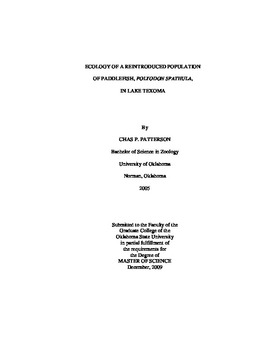| dc.contributor.advisor | Fisher, William L. | |
| dc.contributor.author | Patterson, Chas Patrick | |
| dc.date.accessioned | 2014-04-15T21:59:51Z | |
| dc.date.available | 2014-04-15T21:59:51Z | |
| dc.date.issued | 2009-12-01 | |
| dc.identifier.uri | https://hdl.handle.net/11244/9187 | |
| dc.description.abstract | A reintroduction of paddlefish in Lake Texoma began in 1999 but subsequent annual surveys showed this population below that produced from other similar reintroductions in Oklahoma. To determine the current status of this population, 30 paddlefish were implanted with ultrasonic transmitters in 2008 and 2009 to determine their distribution and movements in the lake. Log-likelihood chi square tests and selection ratios were used to determine which areas of the lake paddlefish selected for and against. Linear home range was also calculated for each season and analysis of variance (ANOVA) was used to determine differences in seasons. The main tributaries of the lake were also monitored during the spring of 2007 to document spawning migrations. In addition, a stratified random sampling design was used to collect paddlefish with gill nets to estimate total abundance by modified Schnabel mark-recapture methods. Population characteristics such as growth and mortality were also determined from the netting data. Paddlefish in Lake Texoma selected for the upper Red River arm and against the lower lake in both 2007 and 2008 as indicated by selection ratios. Linear home range was not different among seasons P = 0.18 or between years P = 0.13. Paddlefish had an annual linear home range from 5.97 to 61.44 km with a mean of 37.41 km. The paddlefish population was estimated at 1,346 (95% CIs: 701-4,925), and 1,761 (95% CIs: 869-8,610) fish in 2008 and 2009, respectively. Paddlefish exhibited growth similar to other Oklahoma populations although mortality estimates of approximately 40% are higher than most other unexploited populations. Paddlefish migrated up the Washita River during the spring of 2007, although no reproductive activity or verification of naturally produced fish was documented. The success of the Lake Texoma paddlefish population will be highly dependant on adequate inflow to support successful natural reproduction. | |
| dc.format | application/pdf | |
| dc.language | en_US | |
| dc.publisher | Oklahoma State University | |
| dc.rights | Copyright is held by the author who has granted the Oklahoma State University Library the non-exclusive right to share this material in its institutional repository. Contact Digital Library Services at lib-dls@okstate.edu or 405-744-9161 for the permission policy on the use, reproduction or distribution of this material. | |
| dc.title | Ecology of a reintroduced population of paddlefish, Polyodon Spathula, in Lake Texoma | |
| dc.type | text | |
| dc.contributor.committeeMember | Echelle, Anthony A. | |
| dc.contributor.committeeMember | Shoup, Daniel E. | |
| osu.filename | Patterson_okstate_0664M_10687.pdf | |
| osu.college | Agricultural Sciences and Natural Resources | |
| osu.accesstype | Open Access | |
| dc.description.department | Department of Natural Resource Ecology and Management | |
| dc.type.genre | Thesis | |
| dc.subject.keywords | paddlefish | |
| dc.subject.keywords | telemetry | |
| dc.subject.keywords | texoma | |
